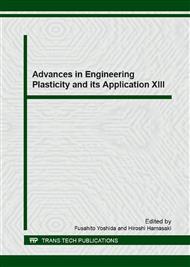p.261
p.267
p.275
p.281
p.287
p.293
p.299
p.305
p.311
Application of Subloading Surface Model to Heat Treatment Simulation Based on Explicit Finite Element Method
Abstract:
The heat treatment simulation based on the explicit finite element method was developed. The subloading surface model considering the phase transformation was implemented in VUMAT of commercial FE code Abaqus/explicit. It is expected that the error of explicit analysis decrease in the stress integration, since the subloading surface model has an ability of pulling back stress state automatically to the yield surface in the plastic loading process. The formulation of subloading surface model in metallo-thermo-mechanics is presented, and the verification of the presented model is shown by the finite element quenching simulation. The deviation from the yield surface is less than that of the conventional explicit analysis, and the computation time is considerably less than that of the implicit analysis.
Info:
Periodical:
Pages:
287-292
Citation:
Online since:
December 2016
Authors:
Price:
Сopyright:
© 2017 Trans Tech Publications Ltd. All Rights Reserved
Share:
Citation:


